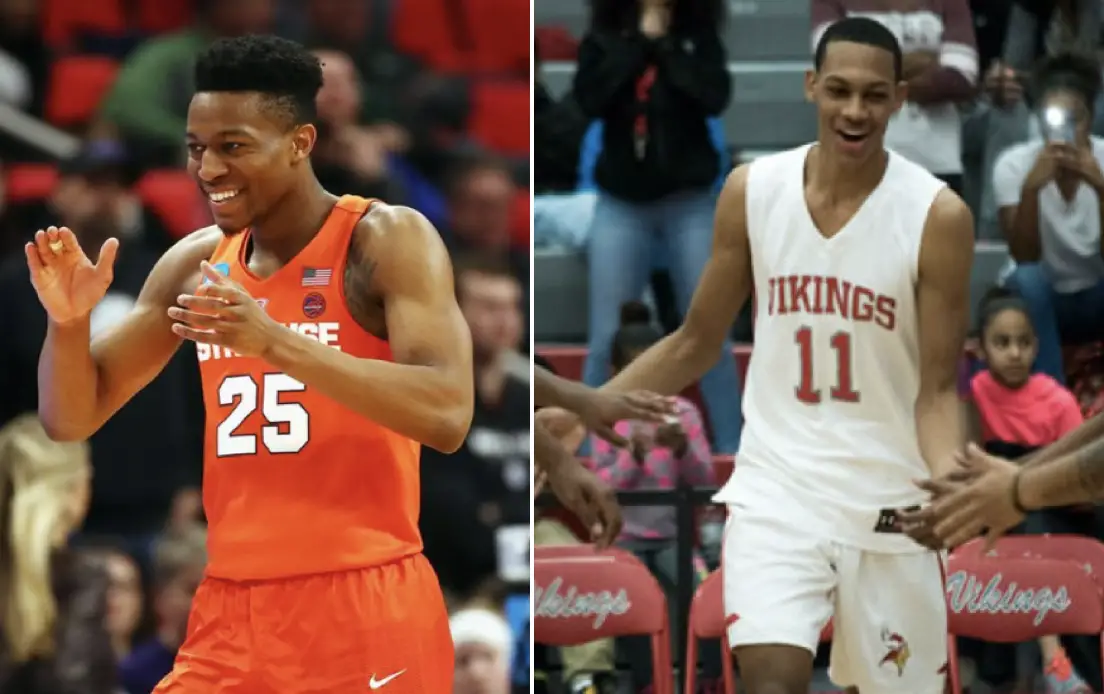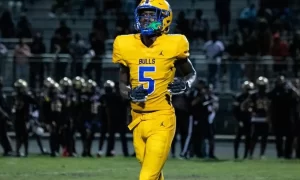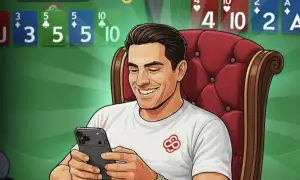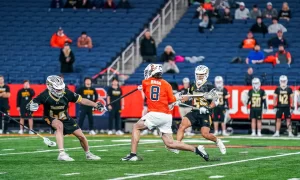Feelings aside, this is definitely a conversation worth having. Obviously, one player bailed on Syracuse before even stepping foot on the court while the other played in 103 games over three years, and led SU in scoring twice. Syracuse fans will have drastically different memories of Tyus Battle and Darius Bazley – perhaps even opposing memories. However, that won’t impact how either player is remembered in the NBA.
This discussion goes beyond what the current draft rankings say. From before the season until this very day, Bazley has been slated – via consensus – to be the earlier pick.
This has Darius Bazley at No.18, Tyus Battle at No.27 and Oshae Brissett at No.33. Had Bazley stayed at @Cuse, would have been 3 draft picks on one team. Long way to go but I think Oshae goes before Tyus next year. https://t.co/BcQto8YmTA
— Brent Axe (@BrentAxeMedia) June 23, 2018
After a season full of competitive basketball from Battle and none from Bazley, the gap between the two players widened, with both sliding down the board considerably.
No Tyus Battle on this mock. Darius Bazley listed at No. 42. https://t.co/cf5YU6P7ws
— Brent Axe (@BrentAxeMedia) March 19, 2019
It seems certain that Bazley will go higher than Battle – if Battle goes at all. What seems less certain, however, is Bazley carving out a better NBA career than the former SU standout. Only time will tell on that one… not draft stock.
Both players face respectively different hurdles heading into June’s draft. For Battle, in the world of one-and-dones, playing too long at school often seems to negatively affect a player’s stock. We’ve certainly seen this before, where big names from the college ranks have fallen after entering the draft as juniors or seniors. Better yet, many of these players still wound up contributing on NBA teams. Just over the past three drafts, players such as, Malcom Brogdon, Frank Mason III, Jalen Brunson, Dillon Brooks and Devontae Graham have all secured roles on NBA teams despite sliding to the second round as upperclassmen.
That definitely does not mean Battle’s NBA fate is sealed – in fact, far from it. What it does mean, is similar to many other recent NBA prospects with extended college experience, Battle’s age likely hurts his draft stock. In addition, his three years at Syracuse also might have him falling in the draft for a different reason.
When you combine Battle’s heavy usage with the lack of offense Syracuse runs, you get a considerable amount of either forced, or low-quality shots. As SU’s go-to-guy for two straight seasons, Battle fell victim to some unavoidable inefficiency. Sure, he was not perfect, but even so, his job was often made far more difficult than he gets credit for.
As a sophomore in 2017-2018, the Orange essentially became Battle’s team. His 28.1 usage percentage ranked 3rd in the ACC that year, which was also a 10-percent uptick from the season prior. Coinciding with Battle’s usage increase were decreases in offensive rating – a stat measuring the efficiency of either a team or an individual player in regards to producing points. As Battle’s usage rate climbed in his sophomore season, his individual offensive rating sunk from 116.5 as a freshman, to 108.0 in 2017-2018. Furthermore, because of the way Syracuse started forcibly playing through Battle, their team offensive rating dropped from 116.6 to 102.4 – or in other words, 41st in the nation to an eye-opening 237th (out of 351). This was also the same year Battle led the ACC in shot attempts, shooting over 60 times more than the second-highest player.
At this point, Battle’s 19.2 points per game (4th in the ACC) had him being talked about by some as a borderline first-round pick. One year later, the conversation is now over whether or not he’ll be drafted at all, and quite frankly it’s unfortunate.
Despite a 2-point decrease in his points per game average, Battle still might have actually had a better year in 2018-2019. His offensive rating was slightly higher, as was SU’s as a team – coincidence? I think not. As a junior, Battle also raised his overall field goal percentage, and set career highs in assists and rebounding. Yes, he struggled from the free throw line, but it would be crazy to suggest he’s far removed from his ’16-’17 self when he knocked down nearly 84 percent of his foul shots. It’s also worth noting Battle was able to lead the Orange to some important wins this season while occasionally playing out of position because of lineup absences.
In the case of Bazley, the biggest question surrounding the former five-star recruit is that he is unproven. While other players have shown out and improved their draft stock over the past year, Bazley hasn’t played competitive basketball – a gamble that even his agent Rich Paul admits carries risk. When considering his unique skillset for his size – as a scorer, passer and defender – along with his youth (doesn’t turn 19 until June), it would certainly make sense to see Bazley go ahead of Battle in the draft. However, the question is about whose game will translate better – not who people think will get drafted higher.
The reason it may be closer than mock drafts indicate – and perhaps the real draft as well – is because Battle is very likely a more polished product at the moment. For an inexperienced player like Bazley, not playing in college or any form of competitive basketball can be a crucial developmental hindrance. Bazley might be in adequate physical shape after spending the year preparing for the draft, but it wouldn’t be irrational to question what kind of “basketball shape” he is in after sitting out for quite some time. Even tougher than simply taking a year off from basketball, doing it between high school and the pros likely makes it incredibly difficult to adjust upon returning. If the game speeds up from college to the pros, one can only imagine the hurdle Bazley will face when entering the league from high school after an entire year removed from competitive basketball. Additionally, at 6-foot-9 and less than 200 pounds, it’s extremely important Bazley adds weight in the near future.
Problems like those are ones that Battle just doesn’t have to deal with. The 6-foot-6 guard already has an NBA frame for a player at his position, and has multiple years of experience – not just normal college experience, but experience being one of the best players in arguably the nation’s strongest conference. This almost definitely means there will be less of an adjustment period for Battle upon entering the league, and arguably less risk involved with drafting him as opposed to Bazley.
Oftentimes, NBA general managers understandably take players with lower floors but higher ceilings rather than the other way around. This figures to be the consensus over what will happen with Battle and Bazley regarding which player finds an NBA team first. One thing we’ve learned over time, especially in recent years past, is that opting for the lower floor and higher ceiling carries risk, and doesn’t always prove to be the smartest move. Between Battle’s polish and Bazley’s inexperience, we might have one of those scenarios on our hands despite the two players’ respective draft stocks. Oftentimes hidden behind practically inevitable inefficiency, the talent Battle possesses could certainly find him on an NBA roster, and contributing more than Bazley – at least at the start, with Bazley being so presumably raw. All in all, it will be interesting to see how the next 5-to-10 years pan out for these two remarkably different NBA prospects with Syracuse ties. Stay tuned.


















